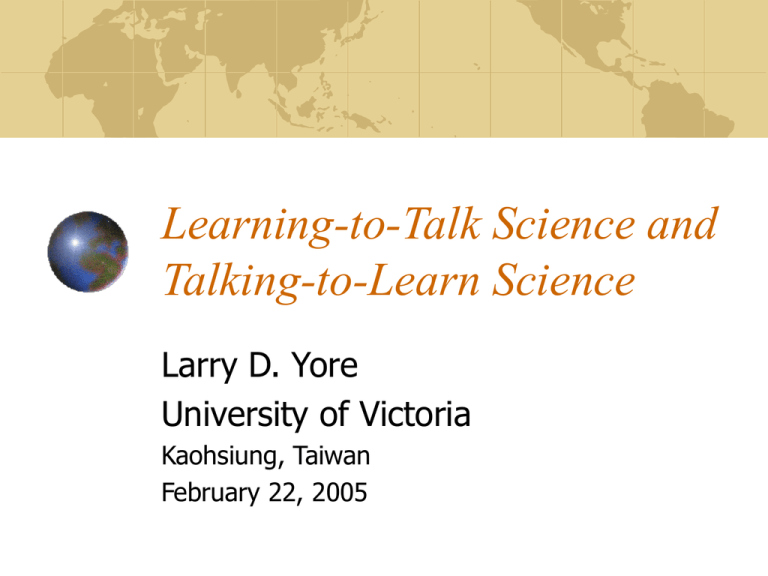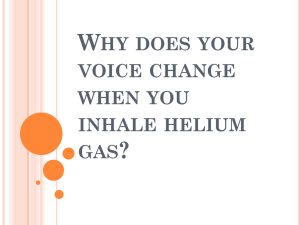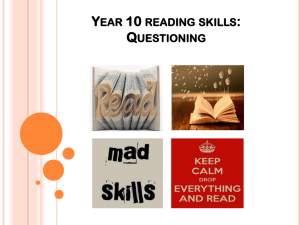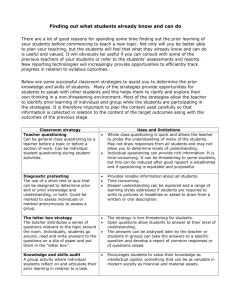Oral Language in Science
advertisement

Learning-to-Talk Science and Talking-to-Learn Science Larry D. Yore University of Victoria Kaohsiung, Taiwan February 22, 2005 Contemporary Science Literacy: Interacting Components (Yore, 2000) Abilities, Thinking, and Habits of Mind to Construct Disciplinary Understanding Communications to Inform and Persuade Big Ideas/Unifying Concepts Students need to orally present and to follow oral directions, state purpose for the stepwise procedures, and produce compelling arguments, sound causal explanations, or clear descriptions 2 Oral Language in Science (Lemke in Saul, 2004; Yore in Saul, 2004) Oral language in science is different than everyday language — The 3–Language Problem: ‘theory’ has a specific meaning at home, at school, and in science. Oral language is necessary, but not sufficient, to do science that: Stresses abstract concepts, models, and theories Requires accurate descriptions, complex procedures, causeeffect explanations, and compelling arguments Promotes ownership, documents intellectual properties, and communicates across distance and time Supplies permanent records 3 Modern View of Science: Naïve Realist Ontology and Evaluativist Epistemology (Yore in Saul, 2004; Yore, Hand, & Florence, 2004) Science knowledge is a temporary explanation that best fits the existing evidence, established knowledge, and current thinking about reality as we know it. 4 Modern View of Science (continued) Science knowledge claims are open to repeated public evaluation. Language is not a exact transcription of scientific inquiry — Science reports are not records of actual actions. Language shapes as well as reports science ideas — Scientists use metaphors to capture their mental images and the metaphor starts to influence their thinking. Language must reflect the tentative and temporary nature of science claims — Science does not ‘prove’; it only rejects or supports hypotheses. 5 Most Students are Science Language Learners (SSL) The 3–Language Problem: Home language (L1), school language (L2), and science language (L3) frequently do not match. (Gee in Saul, 2004) Instruction needs to associate experience and language. Instruction must start with the student’s home language and move toward the languages of instruction and science. 6 SSL & 3L (continued) Anchoring science ideas in students’ home language terms engages students and respects their backgrounds. Instruction must not leave students believing their home language terms are representative of scientific terminology. As students acquire science language they may lose their home language. 7 Oral Discourse in the Constructivist Approach: Learning Cycle (Shymansky, Yore, & Anderson, 2004) Engage — Access, assess, and challenge learners’ prior knowledge Explore — Allow opportunities for learners to investigate the target concepts with hands-on, visual, and language experiences Consolidate — Scaffold the learners’ interpretations of the experiences and connect to the established understandings Assess — Document learners’ ideas in all parts of the cycle to facilitate and evaluate learning 8 Learning Matrix Meaningful Level of Learning Rote Drill Debate Process of Learning 9 Oral Language Promotes Cognitive Symbiosis Between Fundamental and Derived Senses of Science Literacy (1) Learning to talk/argue and talking/arguing to learn Little meaningful oral discourse occurs in most science classrooms: Most oral discourse in classrooms does not reflect scientific discourse It is social, not focused and purposeful 10 Oral Language Promotes Cognitive Symbiosis Between Fundamental and Derived Senses of Science Literacy (2) Patterns of Verbal Interactions 1964; Shymansky, 1978) (Flanders, Traditional Science Lesson • One-way: lecture • Two-way and uni-directional: teacher to student (t-s) Inquiry Science Lesson • Two-way and multi-directional: t-s, s-t, s-s 11 Talking Science: Oral Discourse and Concrete Experiences (Wellington & Osborne, 2001) Student talk must be associated with sensory experiences to ensure vocabulary development. Rich oral discussions within and between student groups encourage consideration of alternative interpretations and causality. Oral language should inform, persuade, and help construct science knowledge: Argument and Debate Discuss Alternatives and Promote Learning Reveal Relationships among Experiences Consolidate and Integrate Learning 12 Oral Discourse and Classroom Questioning Teacher questioning needs to reflect the phase and purpose of inquiry Wait-time: 3 seconds among question, response, and further questions (Rowe, 1996) Use specific types of questions for specific purposes Chained Questions: Response and rationale Debating Science, Technology, Society, and Environment Issues Argumentation: The process of argument 13 Classroom Questioning: Matching Strategic Purpose (1) Engage Phase: Question sequence accesses prior knowledge, motivates, challenges existing ideas, and establishes problem focus for investigation (Gilbert, 1992) Lower-level: Recall, translation, elaboration Questions that relate to students’ interest and lives Higher-level: Application, synthesis, evaluation • These questions focus on how, where, and epistemic justification • One or more questions will not be ‘answerable’ at this time • One or more questions need to be researchable • One or more questions will serve as the focus for the inquiry • An investigation will be planned to investigate one or more of these questions 14 Classroom Questioning: Matching Strategic Purpose (2) Explore Phase: Use ‘productive questions’ that match the small groups’ actions, concerns, and inquiry (Martens, 1999) Attention-Focusing: Draw students’ attention to significant details Measuring and Counting: Encourage students to be more precise about their observations Comparison: Encourage students to analyze and classify Action: Encourage students to make predictions or observations based on events Problem-Posing: Assist students to plan and implement solutions to problems Reasoning Questions: Encourage students to think about experiences and help them make sense of these experiences 15 Attention-Focusing Questions (2a) Draw students’ attention to significant details Have you seen … ? What have you noticed about … ? What are they doing? What does it feel/smell/look like? 16 Measuring and Counting Questions (2b) Encourage students to be more precise about their observations How How How How many … ? often … ? long … ? much … ? 17 Comparison Questions (2c) Encourage students to analyze and classify: Compare and contrast reflections How are these the same or different … ? How do they go together … ? 18 Action Questions (2d) Encourage students to make predictions or observations based on events What do you expect to happen? What would happen if you changed this? What if … ? 19 Problem-Posing Questions (2e) Assist students to find problems, state researchable questions, and plan and implement solutions to problems What is a central problem in this issue? Can this question be tested? What would you manipulate, and what would you observe? Can you find a way to … ? Can you figure out how to … ? 20 Reasoning Questions (2f) Encourage students to think about experiences and help them make sense of these experiences and potential causality. Why do you think … ? What is your reason for … ? Can you invent a rule for … ? What have you noticed about … when you do this? 21 Classroom Questioning: Matching Strategic Purpose (3) Consolidation Phase: Chained series of teacher’s/ students’ questions should promote knowledge construction, justification of claims with evidence, explanation based on theoretical foundations, etc. (Penick, Crow, & Bonnstetter, 1996) Questioning and question sequence should consider: Sharing experiences and data Organizing and interpreting data Alternative interpretations Chained interpretation, rationales, and justification for interpretations between two or more students Application of new ideas to relevant issues Integration of new ideas into prior conceptual networks (conceptual growth or conceptual change) 22 References for Oral Discourse and Classroom Questioning (1) Flanders, N. A. (1964). Some relationships among teacher influence, pupil attitudes, and achievement. In B. J. Biddle & W. J. Ellons (Eds.), Contemporary research on teacher effectiveness (pp. 196-231). New York: Holt, Rinehart & Winston. Gilbert, S. W. (1992). Systematic questioning. Science Teacher, 59(December), 41-46. Latham, A. (1997). Asking students the right questions. Educational Leadership, 54(6), 84-85. Martens, M. L. (1999). Productive questions: Tools for supporting constructivist learning. Science and Children, 36(8), 24-27 & 53. 23 References for Oral Discourse and Classroom Questioning (2) Maxim, G. (1997). When to answer the question ‘why?’. Science and Children, 35(3), 41-45. Otto, P. B. (1991). Finding an answer in questioning strategies. Science and Children, 28(7), 44-47. Penick, J. E., Crow, L. W., & Bonnstetter, R. J. (1996). Questions are the answers. Science Teacher, 63(1), 26-29. Rowe, M. B. (1996). Science, silence, and sanctions. Science and Children, 34(1), 35-38. 24 References for Oral Discourse and Classroom Questioning (3) Schielack, J. F., Chancellor, D., & Childs, K. (2000). Designing questions to encourage children’s mathematical thinking. Teaching Children Mathematics, 6, 398-402. Shymansky, J. A. (1978). Assessing teacher performance in the classroom: Pattern analysis applied to interaction data. Studies in Education Evaluation, 4, 99-106. Wellington, J., & Osborne, J. (2001). Language and literacy in science education. Philadelphia, PA: Open University Press. 25 Debates and Arguments Involving Science, Technology, Society and Environment Issues (STSE) (Yore, Bisanz, & Hand, 2003) STSE issues provide ill-structured problems, multiple solutions, and rich contemporary contexts STSE issues involve trade-off among science, technology, and societal values Apply authentic debating procedures King’s College London Project (Osborne, Erduran, & Simon, 2004) 26 Scientific Arguments (Osborne, Erduran, & Simon, 2004) Elements of Argumentation Claims Evidence Warrants Backings Counter-claims Qualifications Rebuttals 27 Classic Pattern of Argumentation (Toulmin, 1958) Evidence Claims Warrants Backings 28 Example of a Classic Argument (Yore, et al., 2004) Examination of SARS patients and healthy people SARS Caused by a virus Warrant 1: A unique virus (corona) was isolated by UVic and UBC scientists. Warrant 2: SARS patients’ blood and body fluids contain the virus. Backing 1: Established knowledge about respiratory diseases Backing 2: Influenza is caused by a virus, not bacteria. 29 Extended Pattern of Argumentation (Toulmin, 1958) Evidence Qualifiers and Counter-claims Warrants Claims Rebuttal Backings 30 Example of an Extended Argument (Yore, et al., 2004) Examination of: AIDS and healthy patients HIV in some people HIV was found in all AIDS patients and some healthy patients HIV causes AIDS People with weak immune systems 31 Other Oral Language Tasks Group-Generated Concept Maps Structured Controversy: Debate, Evaluate, Debate, and Draw Consensus (Johnson & Johnson, 1985) Jig-Saw Projects (Cooperative Learning): Distributed expertise 32 Concept Mapping (Novak & Gowin, 1984) 33 Group-Generated Concept Maps Use large (5 by 8) and small index cards (3 by 5), masking tape, and string Have small groups of 3-4 students develop a concept map about a controversial topic Nature of science Global warming Write the concepts on the large cards and the connecting relationship words on the small cards Use the string and masking tape to show connections to produce propositions (2 concepts connected with a relationship word) and cross-links between concept clusters 34 Group-Generated Concept Maps using ICT software Use Kidspiration (kidspiration.com) or Inspiration (inspiration.com) to develop and share concept maps These software programs are available on free short-term trial. They allow elementary, secondary, and university students to create concept maps and other graphic organizers. 35 Structured Controversy of STSE Issues — Sequential Debates Debate STSE issue: Pro (for) or Con (against) positions Analyze opponents’ presentation Switch positions Debate STSE issue again from the opposite position Develop a consensus or collective position for the class on the STSE issue 36 Jig-Saw Cooperative Learning Approach Home Groups Expert Groups 37 Jig-Saw Approach for Simple Harmonic Oscillators (1) Class is divided into groups of 3 students (Home group) Students in each ‘Home’ group are assigned one of three investigations Effect of pendulum length on frequency Effect of pendulum mass on frequency Effect of mass on the frequency of a spring oscillator 38 Jig-Saw Approach for Simple Harmonic Oscillators (2) Three students doing the same investigation form into ‘Expert’ group to do the investigation and become knowledgeable about the procedures and outcomes ‘Expert’ students return to their ‘Home’ group to demonstrate and explain their investigation to the other 3 non-expert students on that topic. The other ‘Experts’ do the same for their investigation The ‘Home’ group discusses ideas and constructs a composite understanding about simple harmonic oscillators (pendulums and springs) 39 References Johnson, R. T., & Johnson, D. W. (1985). Using structured controversy in science classrooms. In R. W. Bybee (Ed.), Science technology society: 1985 yearbook of the National Science Teachers Association (pp. 228-234), Washington, DC: National Science Teachers Association. Norris, S. P., & Phillips, L. M. (2003). How literacy in its fundamental sense is central to scientific literacy. Science Education, 87, 224-240. Novak, J. D., & Gowin, B. D. (1984). Learning how to learn. Cambridge, UK: Cambridge University Press. Osborne, J., Erduran, S., & Simon, S. (2004). Enhancing the quality of argumentation in school science, Journal of Research in Science Teaching, 41, 994-1020. 40 References (continued) Paul, R., & Elder, L. (2003). How to improve student learning: 30 practical ideas. Dillon Beach, CA: The Foundation for Critical Thinking. Saul, E. W. (Ed.) (2004). Crossing borders in literacy and science instruction. Newark, DE: International Reading Association/National Science Teachers Association. Shymansky, J. A., Yore, L. D., & Anderson, J. O. (2004). Impact of a school district’s science reform effort on the achievement and attitudes of third- and fourth-grade students. Journal of Research in Science Teaching, 41, 771-790. Toulmin, S. (1958). The uses of argument. Cambridge, UK: Cambridge University Press. 41





